|
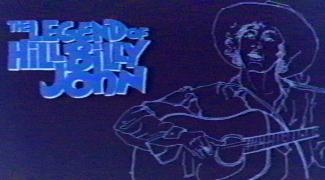
Now, this here is what
we refer to as a tough call. In a lot of ways, it's neither fish nor
fowl; it can't really be judged by the same criteria applied to the
rest of the films on this site, and yet, it has to be, since in the
final analysis it's a low-budget fantasy film, despite whatever other
pretensions it may have.
The Legend of Hillbilly
John is based on several of Manley Wade Wellman's excellent Silver
John stories, stand-alone horror tales that draw on the rich vein of
Appalachian folklore. The stories have been collected several times,
as Who Fears the Devil? (the original, apparently unmarketable
title of this movie), and most recently as John the Balladeer.
A fellow named Marduke
(Severn Darden), a dowser by trade, introduces the movie to us by the
simple expedient of speaking directly to the camera. He tells us that
here in the Appalachians, the devil is quite real, and goes by any number
of names... one of which is the Army Corps of Engineers. Jarringly,
he steps from a pastoral wooded scene to a highway construction area,
and begins to tell us the tale of John.
The first story, which
might be called "The Origin of Hillbilly John", begins with
John (Hedges Caper), recovering from a night of pleasure with his girlfriend
Lily (Sharon Henesy) by singing a new song all the way back into town,
only to find that in his absence, his Grandpappy John (Denver Pyle)
has decided to "sing the Defy", an act which will bring him
into conflict with the Devil himself.
Grandpappy, however,
has an ace up his sleeve: he has scraped up enough money for five new silver dollars, "each with face of poor Mr. Kennedy shinin' like
a new sun." He melts down the coins and draws them into strings
for his guitar, for the Devil fears "true silver". Grandpappy
sings the Defy, but loses his gamble and his life, because, of course,
silver dollars haven't been silver for some time. "The Government
of Men," we are informed, "is hand in hoof with Him."
silver dollars, "each with face of poor Mr. Kennedy shinin' like
a new sun." He melts down the coins and draws them into strings
for his guitar, for the Devil fears "true silver". Grandpappy
sings the Defy, but loses his gamble and his life, because, of course,
silver dollars haven't been silver for some time. "The Government
of Men," we are informed, "is hand in hoof with Him."
John swears to follow
in Grandpappy's footsteps, and Marduke does his dowsing act to find
several Spanish pieces-of-eight with which to string Jon's guitar with
true silver; he takes his leave of Lily, and with only the companionship
of Grandpappy's hound dog Honor, takes his act on the road, traveling
and fighting evil. You know, like Kane in Kung Fu.
In the second story,
John confronts Zebulon Yandro (Harris Yulin), the latest in a line of
greedy undertakers who have made lots of money off peoples' grief (don't
get me started), and seems in general to spend his time crashing parties
and bumming people out. According to John's encyclopedic knowledge of
folklore (via old songs handed down from Grandpappy, among others) Yandro's
grandfather promised a witch girl he'd "lie in her arms for a year"
if she witched up some gold for him out of her hill. Of course,
being a blackguard, he splits with the gold and reneges on his half
of the deal, and the witch girl witched up a whole lot more gold
in hope of drawing her errant lover back, but to no avail; and so it
has been for 75 years.
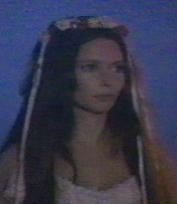 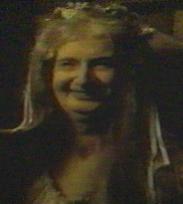 Learning that there's a bunch of
gold with his name on it, Yandro convinces John to take him to that
hill - and of course they have to be there at midnight to see the gold,
because that's how it works. Not only do they see the gold, but they
find the witch girl, still waiting for her lover. Upon discovering that
she is Susan Strasberg, Yandro eagerly agrees to fulfill his grandfather's
promise: a year in her arms for the gold. After the witch girl offers
John some cryptic directions, he leaves them, but no sooner does the
door close on her cabin than the witch girl ages to her true 75-plus
years, and Yandro finds himself trapped in a doorless, windowless room
with a hag. Learning that there's a bunch of
gold with his name on it, Yandro convinces John to take him to that
hill - and of course they have to be there at midnight to see the gold,
because that's how it works. Not only do they see the gold, but they
find the witch girl, still waiting for her lover. Upon discovering that
she is Susan Strasberg, Yandro eagerly agrees to fulfill his grandfather's
promise: a year in her arms for the gold. After the witch girl offers
John some cryptic directions, he leaves them, but no sooner does the
door close on her cabin than the witch girl ages to her true 75-plus
years, and Yandro finds himself trapped in a doorless, windowless room
with a hag.
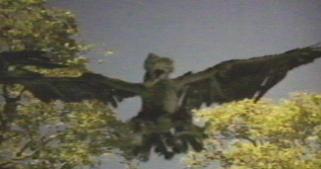 Next, John (or, more actually, Honor)
finds the hidden trail to Hark Mountain, where he must face the evil
O.J. Onselm (Alfred Ryder) and his minion, the Ugly Bird. John plays
El Kabong on the Ugly Bird's head, causing it to melt and Onselm to
shrivel and die. Next, John (or, more actually, Honor)
finds the hidden trail to Hark Mountain, where he must face the evil
O.J. Onselm (Alfred Ryder) and his minion, the Ugly Bird. John plays
El Kabong on the Ugly Bird's head, causing it to melt and Onselm to
shrivel and die.
Marduke shows up again,
this time with a surprisingly intelligent van named Abigail, and replaces
John's wrecked guitar. Lily also shows back up, about this time, trying
to convince John to give up his defyin' ways and settle down. Instead,
they wind up on an evil cotton plantation, run by the Voodoo Captain
Lajoie (Percy Rodrigues), who is done away by the mere sight
of the true silver strings.
 Borne aloft by the grateful black
crowd, John once again splits off from the disappointed Lily. Marduke
appears again, offering her a ride home on his donkey, Asmodeus. "Their
type never hangs around long," Marduke tells her. "Defiers.
They always go where they're needed." So, of course, in our closing
shot, we see John walking toward the Capitol building in Washington.
The end. Borne aloft by the grateful black
crowd, John once again splits off from the disappointed Lily. Marduke
appears again, offering her a ride home on his donkey, Asmodeus. "Their
type never hangs around long," Marduke tells her. "Defiers.
They always go where they're needed." So, of course, in our closing
shot, we see John walking toward the Capitol building in Washington.
The end.
As I said before, you
can't judge The Legend of Hillbilly John as you would standard
drive-in or B-movie fare - it's that rarity, a sorta thoughtful film.
In true 1972 style, it wears it's politics painfully on its sleeve a
time or two, with its "highways & dams = evil" pretensions,
and the rather suspect hailing of John as a hero by the black cotton
pickers simply because he brought the guitar (it's the outspoken black
worker who actually does in Captain Lajoie while the villain is choking
the guitarless-and-therefore-helpless John). But all that aside, the
closing image is damn clever. My aging hippie heart embraces
it.
Directed by John Newland
- the host of One Step Beyond for all you oldsters - Hillbilly
John treats its subject matter fairly matter of factly, by which
I mean after a few jarring instances, we fall into the arcane sentence
structure and belief systems of the backwoods pretty easily. The cinematography
is handsome enough, showcasing some beautiful scenery, and the editing
and camera placement is fairly spot on. The major problem we have here
is budget, pure and simple. Newland has overcome it well in a
couple of instances: entering the cotton plantation through enormous
yellow gates, everything is tinted yellow until Lajoie's death; and
as Grandpappy John sings the ultimate line of The Defy (written by Hoyt
Axton, no less), his death is symbolized by the film breaking.
It's an audacious, arty moment, and deserving of applause.
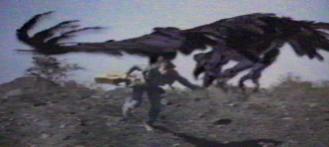 Overall, though, Hillbilly John
reminds me of those impoverished PBS productions of works like The
Lathe of Heaven or Between Time and Timbuktu, where the ideas
count more than splashy graphics or special effects. The only special
effects on display here are the Ugly Bird, a fair piece of stop-motion
animation, and Onselm's withering death, both achieved through very
fuzzy process shots (or, more likely, very primitive rear projection).
The rest of the magic on hand is achieved by sheer dint of acting
- when Yandro is held motionless by some unseen force, and the eye-popping, Overall, though, Hillbilly John
reminds me of those impoverished PBS productions of works like The
Lathe of Heaven or Between Time and Timbuktu, where the ideas
count more than splashy graphics or special effects. The only special
effects on display here are the Ugly Bird, a fair piece of stop-motion
animation, and Onselm's withering death, both achieved through very
fuzzy process shots (or, more likely, very primitive rear projection).
The rest of the magic on hand is achieved by sheer dint of acting
- when Yandro is held motionless by some unseen force, and the eye-popping,
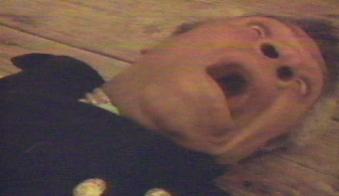 mouth-ever-widening
death of Lajoie. The subject matter cries out for something more spectacular,
and though the filmmaker in me sympathizes, the filmgoer in me feels
cheated. Placing the stories in the modern day, usually an economic
decision, seems rather odd here, as most of the costuming and sets have
a distinctly period feel; in fact, in the few instances when we see
modern devices such as cars, they seem like flagrant anachronisms. Keeping
the stories in their intended early 20th century timespan might have
helped the overall flavor of the movie. mouth-ever-widening
death of Lajoie. The subject matter cries out for something more spectacular,
and though the filmmaker in me sympathizes, the filmgoer in me feels
cheated. Placing the stories in the modern day, usually an economic
decision, seems rather odd here, as most of the costuming and sets have
a distinctly period feel; in fact, in the few instances when we see
modern devices such as cars, they seem like flagrant anachronisms. Keeping
the stories in their intended early 20th century timespan might have
helped the overall flavor of the movie.
Speaking of acting (I
do tend to digress), some of it on display is fairly suspect. Hedges
Caper as 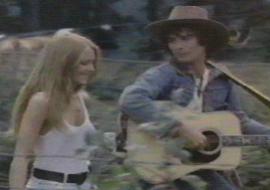 John is especially problematic
- much of the time he gives a very simple, heartfelt performance...
but sometimes one suspects that it is simply because he can't
act. I still don't know, and I suppose its a tribute to the filmmakers
that I don't. In the final analysis, he's likable enough, has a strong,
pleasant voice (he wrote most of the songs, too), and is no real detriment
to the film. His opposite number, Sharon Henesy, gives a performance
equally uncluttered by artifice, but I suspect there is some genuine
talent underneath. It should also be added that if you had to have an
illustration for the term fresh-scrubbed beauty, it would be
Ms. Henesy. In fact, our young lovers would be ideal poster children
for the hippie movement. John is especially problematic
- much of the time he gives a very simple, heartfelt performance...
but sometimes one suspects that it is simply because he can't
act. I still don't know, and I suppose its a tribute to the filmmakers
that I don't. In the final analysis, he's likable enough, has a strong,
pleasant voice (he wrote most of the songs, too), and is no real detriment
to the film. His opposite number, Sharon Henesy, gives a performance
equally uncluttered by artifice, but I suspect there is some genuine
talent underneath. It should also be added that if you had to have an
illustration for the term fresh-scrubbed beauty, it would be
Ms. Henesy. In fact, our young lovers would be ideal poster children
for the hippie movement.
Newland wisely shored
up these two younger actors with some veteran talent, like Strasberg,
Yulin, Ryder, Rodrigues, the ever-dependable Denver Pyle and R.G. Armstrong,
playing a feller who proudly avers he's traveled as far as "Frankfort,
once't or twice't." Past these folks, though, the going gets tough,
with several sub-community theater performances in evidence, though
never long enough to terminally damage the proceedings.
The film's worst failing,
past its chump-change budget, is its structure - the best-developed
of the stories are the first two, with the second two being dispatched
in about ten minutes each. Worse, the plantation story is not truly
resolved by our hero; John could never have faced the Devil - not on
this budget, anyway - but a good, solid climax would have been nice.
Can I recommend The
Legend of Hillbilly John? No, not really. Certainly not for casual
viewing. Though far from being a terrible film, it stands mainly as
a testament to Good Intentions, High Aspirations, and Hope. It is the
sort of film that is more enjoyable in the having seen than actually
seeing....as you ponder the things that might have been, and
could have been, in a just universe.
On the other hand, though,
the music...especially Hoyt Axton's Defy Song, "The Devil",
kicks ass.
|